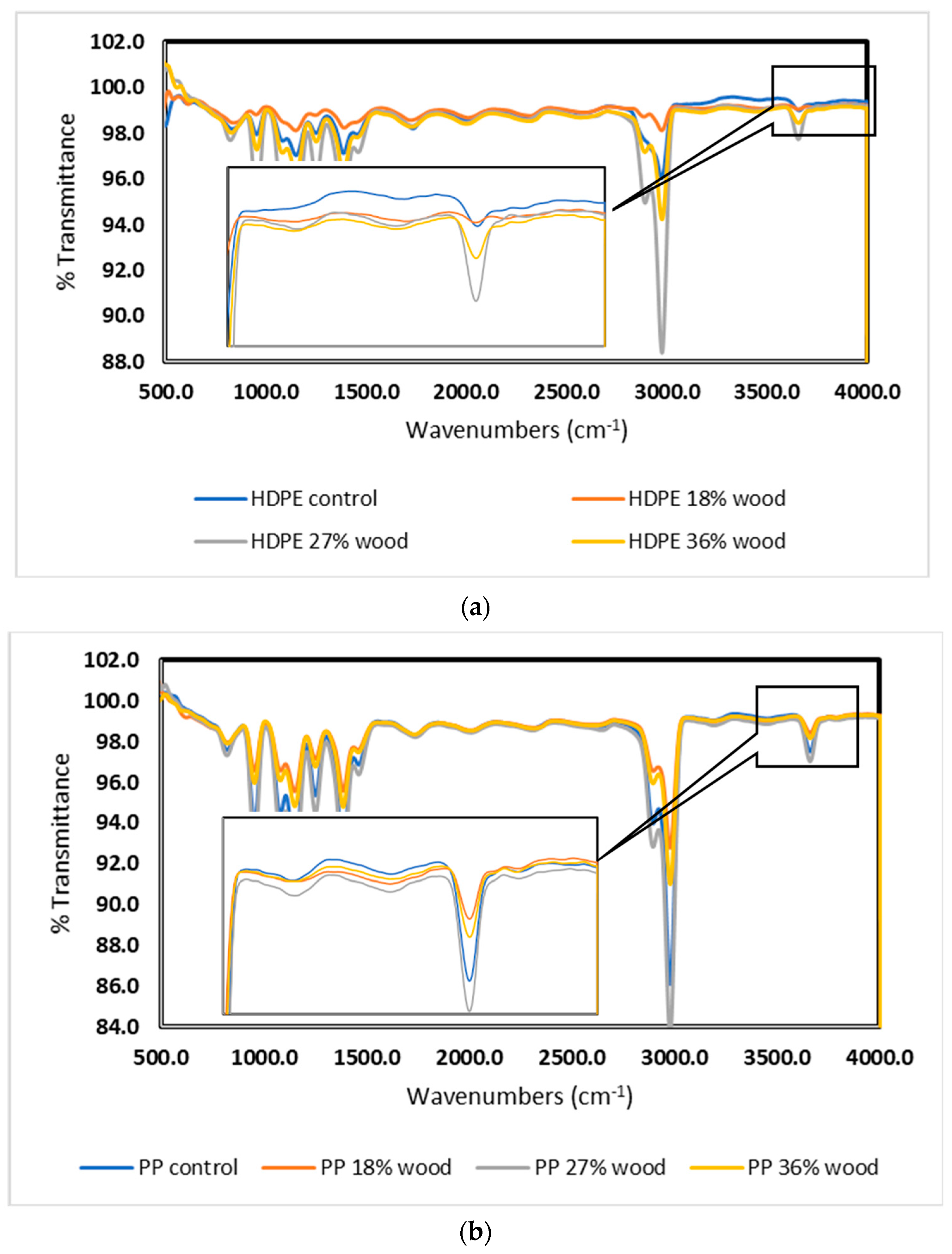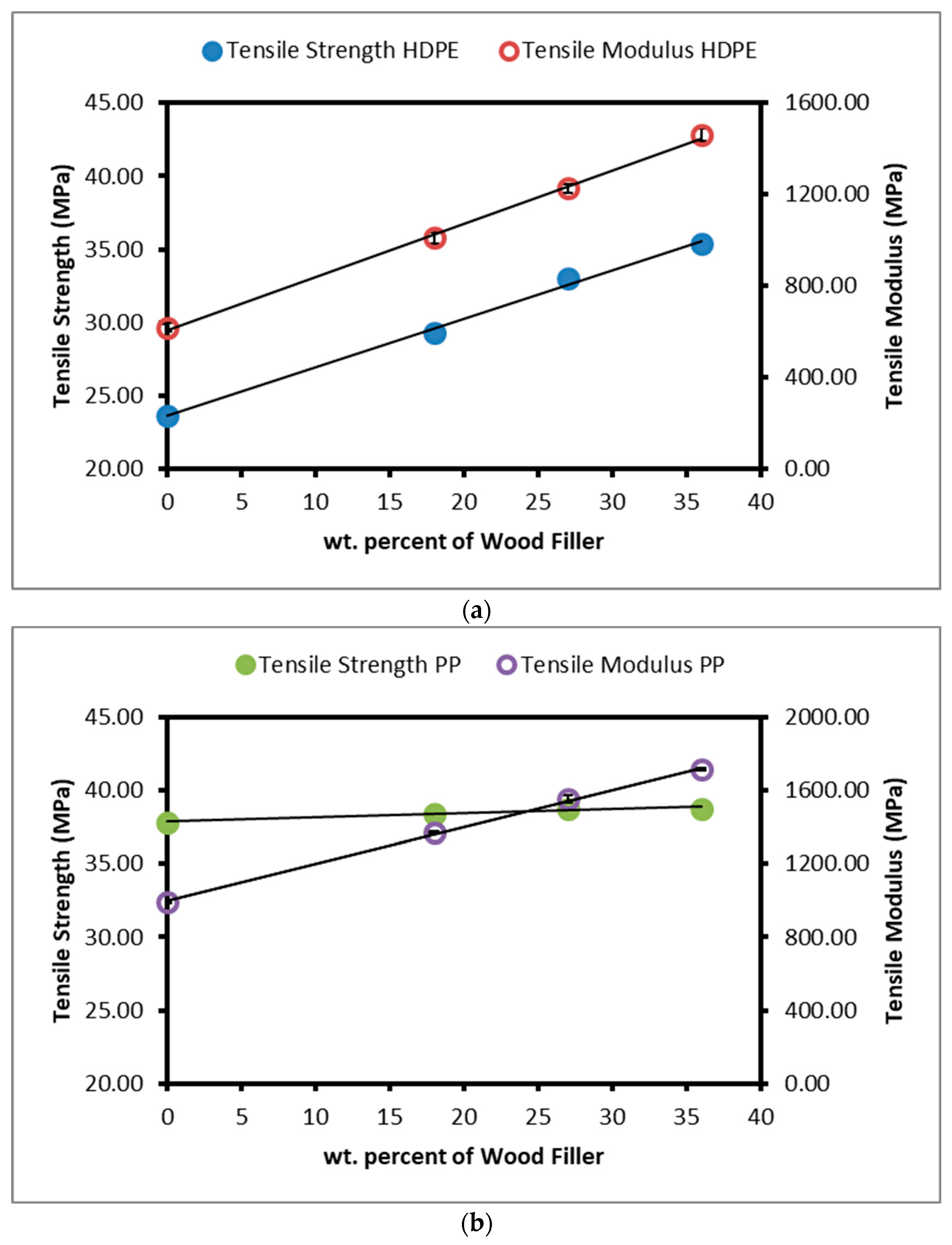Durability of High-Density Polyethylene (HDPE)- and Polypropylene (PP)-Based Wood-Plastic Composites—Part 1: Mechanical Properties of the Composite Materials
Abstract
:1. Introduction
2. Experimental Methods
3. Results and Discussion
4. Conclusions
Author Contributions
Funding
Institutional Review Board Statement
Informed Consent Statement
Data Availability Statement
Acknowledgments
Conflicts of Interest
References
- IEA. World Energy Outlook 2020. Paris, International Energy Agency. 2020. Available online: https://www.iea.org/reports/world-energy-outlook-2020 (accessed on 31 March 2023).
- Gamboa, C.; Towards zero-carbon building In Climate 2020. UNA-UK Publication. 2020. Available online: https://www.climate2020.org.uk/towards-zero-carbon-building/ (accessed on 31 March 2023).
- LEED. LEED Zero Program Guide; The US Green Building Council: Atlanta, GA, USA, 2020. [Google Scholar]
- Khan, M.M.H.; Deviatkin, I.; Havukainen, J.; Horttanainen, M. Environmental impacts of wooden, plastic, and wood-polymer composite pallet: A life cycle assessment approach. Int. J. Life Cycle Assess. 2021, 26, 1607–1622. [Google Scholar] [CrossRef]
- Friedrich, D. Thermoplastic moulding of Wood-Polymer Composites (WPC): A review on physical and mechanical behaviour under hot-pressing technique. Compos. Struct. 2021, 262, 113649. [Google Scholar] [CrossRef]
- Panthapulakkal, S.; Zereshkian, A.; Saim, M. Preparation and characterization of wheat straw fibers for reinforcing application in injection molded thermoplastic composites. Bioresour. Technol. 2006, 97, 265–272. [Google Scholar] [CrossRef] [PubMed]
- Muller, U.; Veigel, S. The strength and stiffness of oriented wood and cellulose-fiber materials: A review. Prog. Mater. Sci. 2022, 125, 100916. [Google Scholar]
- Zhang, W.; Yao, X.; Khanal, S.; Xu, S. A novel surface treatment for bamboo flour and its effect on the dimensional stability and mechanical properties of high-density polyethylene/bamboo flour composites. Constr. Build. Mater. 2018, 186, 1220–1227. [Google Scholar] [CrossRef]
- Wood Plastic Composites Market Size. Share & Trend Analysis Report by Product (Polyethylene, Polypropylene), by Application (Automotive Components), by Region, and Segment Forecasts, 2022–2030; Report ID: 978-1-68038-849-7; Grand View Research: San Francisco, CA, USA, 2022; p. 198. [Google Scholar]
- Najafi, S.K. Use of Recycled Plastics in Wood Plastic Composites—A Review. Waste Manag. 2013, 33, 1898–1905. [Google Scholar] [CrossRef]
- Clemons, C. Wood-plastic composites in the United States: The interfacing of two industries. Forest. Prod. J. 2002, 52, 10–18. [Google Scholar]
- Stark, N.M.; Berger, M.J. Investigations of species effects in an injection molding grade wood filled polypropylene. In Proceedings of the Fourth International Conference on Woodfiber-Plastic Composites, Forest Products Society, Madison, WI, USA, 12–14 May 1997. [Google Scholar]
- Adhikari, K.B.; Pang, S.; Staiger, M. Dimensional stability and mechanical behavior of wood-plastic composites based on recycled and virgin high-density polyethylene (HDPE). Compos. Part B Eng. 2008, 39, 807–815. [Google Scholar] [CrossRef]
- Ashori, A. Wood-plastic composites as promising green-composites for automotive industries. Bioresour. Technol. 2008, 99, 4661–4667. [Google Scholar] [CrossRef]
- Oladejo, K.O.; Omoniyi, T.E. Dimensional Stability and Mechanical Properties of Wood Plastic Composites Products from Sawdust of Anogeissus leiocarpus (Avin) with Recycled Polyethylene Teraphthalate (PET) Chips. Eur. J. Appl. Eng. Sci. Res. 2017, 5, 28–33. [Google Scholar]
- Carus, M.; Eder, A. WPC and NFC market trends. Bioplastics Mag. 2015, 10, 12–13. [Google Scholar]
- Friedrich, D.; Luible, A. Standard-complaint development of a design value for wood-plastic composite cladding: An application-oriented perspective. Case Stud. Struct. Eng. 2016, 5, 13–17. [Google Scholar] [CrossRef] [Green Version]
- Migneault, S.; Koubaa, A.; Perre, P.; Riedl, B. Effects of wood fiber surface chemistry on strength of wood-plastic composites. Appl. Surf. Sci. 2015, 343, 11–18. [Google Scholar] [CrossRef]
- Wei, L.; Cappellazzi, J.; Manning, M.; McDonald, A.G.; Foster, S.; Morrell, J.J. Long-term outdoor weathering evaluation of wood plastic composites. Eur. J. Wood Prod. 2022, 80, 23–34. [Google Scholar] [CrossRef]
- Chen, Y.; Stark, N.M.; Tshabalala, M.A.; Gao, J.; Fan, Y. Weathering Characteristics of Wood Plastic Composites Reinforced with Extracted or Delignified Wood Flour. Materials 2016, 9, 610. [Google Scholar] [CrossRef]
- Ratanawilai, T.; Taneerat, K. Alternative polymeric matrices for wood-plastic composites: Effects on mechanical properties and resistance to natural weathering. Constr. Build. Mater. 2018, 172, 349–357. [Google Scholar] [CrossRef]
- Shahani, S.; Gao, Z.; Qaisrani, M.A.; Ahmed, N.; Yaqoob, H.; Khoshnaw, F.; Sher, F. Preparation and Characterization of Sustainable Wood Plastic Composites Extracted from Municipal Solid Waste. Polymers 2021, 13, 3670. [Google Scholar] [CrossRef] [PubMed]
- Pickering, K.; Efendy, M.A.; Le, T.A. A review of recent developments in natural fibre composites and their mechanical performance. Compos. Part A Appl. Sci. Manuf. 2016, 83, 98–112. [Google Scholar] [CrossRef] [Green Version]
- Razavi-Nouri, M.; Tayefi, M.; Sabet, A. Morphology development and thermal degradation of dynamically cured ethylene-octene copolymer/organoclay nanocomposites. Thermochim. Acta 2017, 655, 302–312. [Google Scholar] [CrossRef]
- Karsli, N.G.; Aytac, A. Effects of maleated polypropylene on the morphology, thermal and mechanical properties of short carbon fiber reinforced polypropylene composites. Mater. Des. 2011, 32, 4069–4073. [Google Scholar] [CrossRef]
- Hafizuddin, M.; Ghani, A.; Ahmad, S. The Comparison of Water Absorption Analysis between Counterrotating and Corotating Twin-Screw Extruders with Different Antioxidants Content in Wood Plastic Composites. Adv. Mater. Sci. Eng. 2011, 2011, 406284. [Google Scholar] [CrossRef] [Green Version]
- Turku, I.; Karki, T. Accelerated weathering of fire-retarded wood-polypropylene composites. Compos. Part A Appl. Sci. Manuf. 2016, 81, 305–312. [Google Scholar] [CrossRef]
- Fabiyi, J.S.; McDonald, A.G.; Wolcott, M.P.; Griffiths, P.R. Wood plastic composites weathering: Visual appearance and chemical changes. Polym. Degrad. Stab. 2008, 93, 1405–1414. [Google Scholar] [CrossRef]
- Strapasson, R.; Amico, S.C.; Pereira, M.F.R.; Sydenstricker, T.H.D. Tensile and impact behavior of polypropylene/low density polyethylene blends. Polym. Test. 2005, 24, 468–473. [Google Scholar] [CrossRef]
- Neagu, R.C.; Gamstedt, E.K.; Lindstrom, M. Influence of wood-fiber hygroexpansion on the dimensional instability of fiber mats and composites. Compost. Part A-Appl. S 2005, 36, 772–788. [Google Scholar] [CrossRef]
- Maldas, D.; Kokta, B.V.; Daneault, C. Thermoplastic composites of polystyrene: Effect of different wood species on mechanical properties. J. Appl. Polym. Sci. 1989, 38, 416–439. [Google Scholar] [CrossRef]
- Razi, P.S.; Raman, A.; Portier, R. Studies on Mechanical Properties of Wood-Polymer Composites. J. Compos. Mater. 1997, 31, 2391–2401. [Google Scholar] [CrossRef]
- Li, T.Q.; Ng, C.N.; Li, R.K.Y. Impact Behavior of Sawdust/Recycled-PP Composites. J. Appl. Polym. Sci. 2001, 81, 1420–1428. [Google Scholar] [CrossRef]
- Lu, J.Z.; Wu, Q.; Negulescu, I.I. Wood-fiber/high-density-polyethylene composites: Coupling agent performance. J. Appl. Polym. Sci. 2005, 96, 93–102. [Google Scholar] [CrossRef]
- Danyadi, L.; Janecska, T.; Szabo, Z.; Nagy, G.; Moczo, J.; Pukanszky, B. Wood flour filled PP composites: Compatibilization and adhesion. Compos. Sci. Technol. 2007, 67, 2838–2846. [Google Scholar] [CrossRef] [Green Version]
- Bouafif, H.; Koubaa, A.; Perre, P.; Cloutier, A. Effects of fiber characteristics on the physical and mechanical properties of wood plastic composites. Compos. Part A—Appl. Sci. Manuf. 2009, 40, 1975–1981. [Google Scholar] [CrossRef]
- Nukala, S.G.; Kong, I.; Kakarla, A.K.; Tshai, K.Y.; Kong, W. Preparation and Characterization of Wood Polymer Composites Using Sustainable Raw Materials. Polymers 2022, 14, 3183. [Google Scholar] [CrossRef] [PubMed]
- Kajaks, J.; Kalnins, K.; Matvejs, J. Mechanical and rheological properties of wood plastic composites based on polypropylene and birch plywood sanding dust. IOP Conf. Ser. Mater. Sci. Eng. 2019, 500, 012001. [Google Scholar] [CrossRef]
- Najafi, S.K.; Hamidinia, E.; Tajvidi, E. Mechanical properties of composites from sawdust and recycled plastics. J. Appl. Polym. Sci. 2006, 100, 3641–3645. [Google Scholar] [CrossRef]
- Gulitah, V.; Liew, K.C. Effect of plastic content ratio on the mechanical properties of Wood-Plastic Composite (WPC) made from three different recycled plastic and acacia fibers. Trans. Sci. Technol. 2018, 5, 184–189. [Google Scholar]




| Material | Mw | Mn | PDI |
|---|---|---|---|
| HDPE Control | 78,428 | 15,208 | 5.16 |
| HDPE-18% wood | 61,839 | 12,871 | 4.80 |
| PP Control | 184,387 | 37,189 | 4.96 |
| PP-18% wood | 190,151 | 32,495 | 5.85 |
| Material | Tensile Strength (MPa) | Elongation at Break (%) | Modulus of Elasticity (MPa) | |||
|---|---|---|---|---|---|---|
| Average | Std. Error | Average | Std. Error | Average | Std. Error | |
| HDPE Control | 23.67 | 0.11 | 1011.87 | 1.84 | 619.01 | 17.94 |
| HDPE-18% wood | 29.35 | 0.36 | 24.53 | 1.58 | 1010.31 | 22.84 |
| HDPE-27% wood | 33.05 | 0.38 | 13.75 | 0.68 | 1226.15 | 17.43 |
| HDPE-36% wood | 35.36 | 0.35 | 9.45 | 0.40 | 1461.73 | 25.46 |
| PP Control | 37.84 | 0.11 | 43.15 | 4.28 | 991.73 | 1.77 |
| PP-18% wood | 38.42 | 0.17 | 9.52 | 0.25 | 1370.90 | 5.68 |
| PP-27% wood | 38.73 | 0.13 | 6.93 | 0.16 | 1553.33 | 19.15 |
| PP-36% wood | 38.77 | 0.28 | 5.87 | 0.09 | 1712.30 | 6.49 |
Disclaimer/Publisher’s Note: The statements, opinions and data contained in all publications are solely those of the individual author(s) and contributor(s) and not of MDPI and/or the editor(s). MDPI and/or the editor(s) disclaim responsibility for any injury to people or property resulting from any ideas, methods, instructions or products referred to in the content. |
© 2023 by the authors. Licensee MDPI, Basel, Switzerland. This article is an open access article distributed under the terms and conditions of the Creative Commons Attribution (CC BY) license (https://creativecommons.org/licenses/by/4.0/).
Share and Cite
Redhwi, H.H.; Siddiqui, M.N.; Andrady, A.L.; Furquan, S.A.; Hussain, S. Durability of High-Density Polyethylene (HDPE)- and Polypropylene (PP)-Based Wood-Plastic Composites—Part 1: Mechanical Properties of the Composite Materials. J. Compos. Sci. 2023, 7, 163. https://doi.org/10.3390/jcs7040163
Redhwi HH, Siddiqui MN, Andrady AL, Furquan SA, Hussain S. Durability of High-Density Polyethylene (HDPE)- and Polypropylene (PP)-Based Wood-Plastic Composites—Part 1: Mechanical Properties of the Composite Materials. Journal of Composites Science. 2023; 7(4):163. https://doi.org/10.3390/jcs7040163
Chicago/Turabian StyleRedhwi, Halim Hamid, Mohammad Nahid Siddiqui, Anthony L. Andrady, Sarfaraz A. Furquan, and Syed Hussain. 2023. "Durability of High-Density Polyethylene (HDPE)- and Polypropylene (PP)-Based Wood-Plastic Composites—Part 1: Mechanical Properties of the Composite Materials" Journal of Composites Science 7, no. 4: 163. https://doi.org/10.3390/jcs7040163






